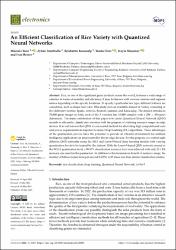| dc.contributor.author | Tasçı, Mustafa | |
| dc.contributor.author | İstanbullu, Ayhan | |
| dc.contributor.author | Kosunalp, Selahattin | |
| dc.contributor.author | Iliev, Teodor | |
| dc.contributor.author | Stoyanov, Ivaylo | |
| dc.contributor.author | Beloev, Ivan | |
| dc.date.accessioned | 2024-07-03T10:13:45Z | |
| dc.date.available | 2024-07-03T10:13:45Z | |
| dc.date.issued | 2023 | en_US |
| dc.identifier.issn | 2079-9292 | |
| dc.identifier.uri | https://doi.org/10.3390/electronics12102285 | |
| dc.identifier.uri | https://hdl.handle.net/20.500.12462/14886 | |
| dc.description | İstanbullu, Ayhan (Balikesir Author) | en_US |
| dc.description.abstract | Rice, as one of the significant grain products across the world, features a wide range of varieties in terms of usability and efficiency. It may be known with various varieties and regional names depending on the specific locations. To specify a particular rice type, different features are considered, such as shape and color. This study uses an available dataset in Turkey consisting of five different varieties: Ipsala, Arborio, Basmati, Jasmine, and Karacadag. The dataset introduces 75,000 grain images in total; each of the 5 varieties has 15,000 samples with a 256 x 256-pixel dimension. The main contribution of this paper is to create Quantized Neural Network (QNN) models to efficiently classify rice varieties with the purpose of reducing resource usage on edge devices. It is well-known that QNN is a successful method for alleviating high computational costs and power requirements in response to many Deep Learning (DL) algorithms. These advantages of the quantization process have the potential to provide an efficient environment for artificial intelligence applications on microcontroller-driven edge devices. For this purpose, we created eight different QNN networks using the MLP and Lenet-5-based deep learning models with varying quantization levels to be trained by the dataset. With the Lenet-5-based QNN network created at the W3A3 quantization level, a 99.87% classification accuracy level was achieved with only 23.1 Kb memory size used for the parameters. In addition to this tremendous benefit of memory usage, the number of billion transactions per second (GOPs) is 23 times less than similar classification studies. | en_US |
| dc.language.iso | eng | en_US |
| dc.publisher | MDPI | en_US |
| dc.relation.isversionof | 10.3390/electronics12102285 | en_US |
| dc.rights | info:eu-repo/semantics/openAccess | en_US |
| dc.rights | Attribution 3.0 United States | * |
| dc.rights.uri | http://creativecommons.org/licenses/by/3.0/us/ | * |
| dc.subject | Rice Classification | en_US |
| dc.subject | Deep Learning | en_US |
| dc.subject | Quantized Neural Network | en_US |
| dc.subject | LeNet-5 | en_US |
| dc.title | An efficient classification of rice variety with quantized neural networks | en_US |
| dc.type | article | en_US |
| dc.relation.journal | Electronics | en_US |
| dc.contributor.department | Mühendislik Fakültesi | en_US |
| dc.contributor.authorID | 0000-0002-8073-8587 | en_US |
| dc.contributor.authorID | 0000-0002-7066-4238 | en_US |
| dc.contributor.authorID | 0000-0003-2214-8092 | en_US |
| dc.contributor.authorID | 0000-0001-9824-1504 | en_US |
| dc.contributor.authorID | 0000-0003-2014-1970 | en_US |
| dc.identifier.volume | 12 | en_US |
| dc.identifier.issue | 10 | en_US |
| dc.identifier.startpage | 1 | en_US |
| dc.identifier.endpage | 16 | en_US |
| dc.relation.publicationcategory | Makale - Uluslararası Hakemli Dergi - Kurum Öğretim Elemanı | en_US |




















